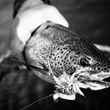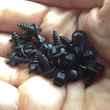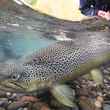It was a slow morning in fast water. It was a small fish day on a big fish river. It was a disappointment by noon, but fate was about to pivot.
I had spent the better part of the morning up to my waist in water cold, enough to numb my toes and stiffen my legs while my upper body fried in the high summer sun, absorbing the ninety degree rays like a sail accepting the wind.
I was wet wading, which is something fishermen do when direct solar energy is enough to bake your noodle into delirium, but you still wish to fish. Walking into a coldwater fishery without waders takes some getting used to, but fishing a tailwater with bottom releases from a dam dumping frigid water in the upper forties takes brave resolve — or stupidity — sometimes they go hand in hand. Eventually, the body balances things out, and some kind of mental regulator switch flicks on and tells the two drastically different temperature zones in the body that neither one is actually in pain and to just relax. In fact, you start to feel downright comfortable after a while, and as the lower half radiates away the terrible heat gained from the upper half, you kinda forget about it all and just fish.
After a full morning immersed in this dichotomy, I was weary, waterlogged and ready for the shift in fortune that came my way.
In the next hour, as I sat on a fallen oak and ate lunch, I watched and felt the weather pattern change. Blankets of thin clouds covered the sun, changing the angular, harsh light that photographers (and trout) hate into duller, friendlier greys. Calm shadows overtook the valley, and as I felt the first raindrops, the transformation was complete.
The shifting weather gave me a new reason to believe, and I positioned myself in the flow and worked up the shallow side of a long island. I caught a few fish, then landed a twenty inch trout that I measured against the simple marks on my net handle. Real twenty — the whiskey mark. I reached deep into my vest pocket for the cool metal container, then took a pull on the flask in celebration of the rare fish, knowing always that, in this river, much bigger fish are a real possibility.
I worked to the top of the island then turned and swung streamers down the primary side. The wind died down and the rain settled into a steady drone. I felt refreshed to stand in the rain, as my torso was now wet and cool and more closely matched with my legs.
When I rounded the outside bend, I circled around to the near side and switched back to nymphs. Then, while tight lining a heavy stonefly pattern just under my rod tip in fast pocket water, it happened. I hooked the biggest fish of my life.
The beast hit with ferocity and I set the hook with equal aggression. Immediately, the fish rocketed to the top and took one huge leap into the humid air.
The magnificent brown trout of my dreams suspended aloft, just between the rise and fall of a leaping trout, only ten feet away. I could have reached out and touched him with my rod tip. It was the biggest wild brown trout I’ve ever seen, and it was hooked to my line.
The moment stopped.
It was, I don't know, about thirty inches?
What?
Wait a second. Let's leave that fish suspended in the air for now and address something.
Trout fishermen have benchmarks — a set of numbers we refer to that defines how unique or rare a fish is. That series of measurements goes something like this, in inches: 15, 18, 20, 24, 30.
And thirty inches seems to be the benchmark where fantasy replaces reality.
That half-foot between twenty-four and thirty inches is an enormous distance, and it takes many (too many) years for a trout to put on the required mass to make up such ground. A thirty inch trout is so much larger than a twenty-inch trout that it seems like a different animal.
But I’m talking here as though they exist.
I once read through a publication that printed, "Thirty-inch wild trout are common in this stretch of water." Now, I don't care what river in the continental United States you want to put up as an example. None of them have thirty-inch wild trout as a regular thing and certainly not in my home state of Pennsylvania. And yet, every fisherman in the parking lot seems to have a thirty-inch fish story, don’t they?
You know what I hear when someone says a fish was “about two feet long?" I hear: "I didn't measure the fish."
Bass guys don't put up with this stuff. My friend, Sawyer (a dedicated bass and musky guy), is dumbfounded by the cavalier way trout fishermen throw estimates around. In his world, if you didn’t measure it, you don’t put a number on it. They take it seriously. We trout fishermen embarrass ourselves with estimates.
Personally, I don't care about the half or quarter inches in between the important numbers. Specifics beyond the benchmarks aren’t a concern to me. It’s enough for me to know that a trout was twenty, and I can get the flask of whiskey out. If it’s twenty-four, my friends and I have taken the habit of granting a trout of that size a proper name (things like El Diablo, Ker-Thunk, Hog Johnson and Slab Daddy). But if it’s thirty? Well, the longer I do this, the more I believe there are no thirty-inch wild trout in my home state of Pennsylvania.
Those who tells stories about thirty-inch trout aren’t really liars, I suppose. They just have unrestrained hope clouding reality and reason.
Now, let's get back to my trout suspended in the air …
I didn’t land it.
I was overmatched. When you finally hook the fish you’ve dreamed of, you may sadly realize that you cannot land it with the same equipment you’ve been using to fool it.
He hit the water broadside, with the startling splat of a failed diver’s belly flop. The splash from the bad entry landed on my glasses, and I watched through spotted amber lenses as he bolted downstream.
I did everything I could to hold on, running parallel to him in shallow water, rod tip high, keeping the line tight until he turned at the tailout. One hundred and eighty degrees. And then he faced the current.
He charged upstream with massive, steady force right through the heart of the heaviest run on the river, against the powerful current and against the pull of my deeply bent graphite rod. That’s when I knew I wouldn’t land him. Not even for one second did I feel there was any possibility of gaining control over the fight. This was not a 5X trout.
He effortlessly continued upstream, recovering fifty yards and passing the pocket where I had hooked him, then further on into a tangle of brush. As he approached the submerged pile of logs and branches, I pulled back as hard as I could, figuring to either break the tippet or turn his head. I did neither. The line stretched and the rod bent more than what I had calculated for, surrendering just enough extra distance for the fish of my dreams to enter the brush. And he was gone.
I’ve never fished 5X on that river again.
He was thirty inches, though no one will believe me. And I wouldn’t blame them.






























Comments
Anonymous replied on Permalink
It's an interesting dichotomy growing up in Alaska. I cut my teeth chasing sockeye and cohos on the Kenai. But in the winter poured over the cabelas catalogs full of bass gear and a page of salmon and trout tackle. When I saw fishing on TV it was bass fishing. I thought bass fishing was the apex of it all. It wasn't until I was a teenager and was catching massive and yes 30+ inch rainbows and dollies as basically bycatch while chasing kings and learning that tourists were paying tens of thousands to chase these rainbows that I knew I was lucky to have easy access to fish that others only dream of.
Josh miller replied on Permalink
"Slab Daddy"!!!!!
Awesome dom
Pages